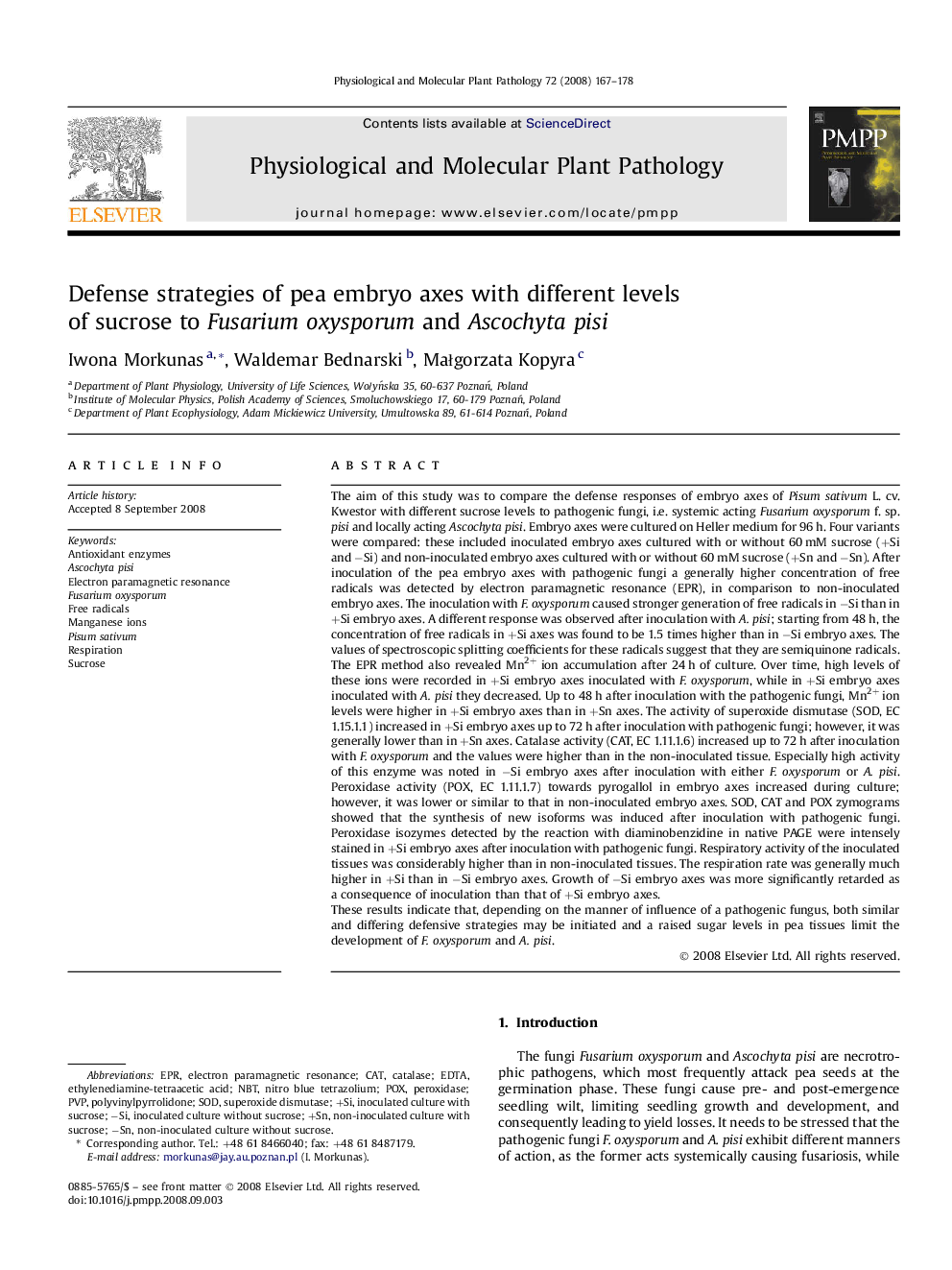| کد مقاله | کد نشریه | سال انتشار | مقاله انگلیسی | نسخه تمام متن |
|---|---|---|---|---|
| 2836684 | 1570868 | 2008 | 12 صفحه PDF | دانلود رایگان |

The aim of this study was to compare the defense responses of embryo axes of Pisum sativum L. cv. Kwestor with different sucrose levels to pathogenic fungi, i.e. systemic acting Fusarium oxysporum f. sp. pisi and locally acting Ascochyta pisi. Embryo axes were cultured on Heller medium for 96 h. Four variants were compared: these included inoculated embryo axes cultured with or without 60 mM sucrose (+Si and −Si) and non-inoculated embryo axes cultured with or without 60 mM sucrose (+Sn and −Sn). After inoculation of the pea embryo axes with pathogenic fungi a generally higher concentration of free radicals was detected by electron paramagnetic resonance (EPR), in comparison to non-inoculated embryo axes. The inoculation with F. oxysporum caused stronger generation of free radicals in −Si than in +Si embryo axes. A different response was observed after inoculation with A. pisi; starting from 48 h, the concentration of free radicals in +Si axes was found to be 1.5 times higher than in −Si embryo axes. The values of spectroscopic splitting coefficients for these radicals suggest that they are semiquinone radicals. The EPR method also revealed Mn2+ ion accumulation after 24 h of culture. Over time, high levels of these ions were recorded in +Si embryo axes inoculated with F. oxysporum, while in +Si embryo axes inoculated with A. pisi they decreased. Up to 48 h after inoculation with the pathogenic fungi, Mn2+ ion levels were higher in +Si embryo axes than in +Sn axes. The activity of superoxide dismutase (SOD, EC 1.15.1.1) increased in +Si embryo axes up to 72 h after inoculation with pathogenic fungi; however, it was generally lower than in +Sn axes. Catalase activity (CAT, EC 1.11.1.6) increased up to 72 h after inoculation with F. oxysporum and the values were higher than in the non-inoculated tissue. Especially high activity of this enzyme was noted in −Si embryo axes after inoculation with either F. oxysporum or A. pisi. Peroxidase activity (POX, EC 1.11.1.7) towards pyrogallol in embryo axes increased during culture; however, it was lower or similar to that in non-inoculated embryo axes. SOD, CAT and POX zymograms showed that the synthesis of new isoforms was induced after inoculation with pathogenic fungi. Peroxidase isozymes detected by the reaction with diaminobenzidine in native PAGE were intensely stained in +Si embryo axes after inoculation with pathogenic fungi. Respiratory activity of the inoculated tissues was considerably higher than in non-inoculated tissues. The respiration rate was generally much higher in +Si than in −Si embryo axes. Growth of −Si embryo axes was more significantly retarded as a consequence of inoculation than that of +Si embryo axes.These results indicate that, depending on the manner of influence of a pathogenic fungus, both similar and differing defensive strategies may be initiated and a raised sugar levels in pea tissues limit the development of F. oxysporum and A. pisi.
Journal: Physiological and Molecular Plant Pathology - Volume 72, Issues 4–6, July–September 2008, Pages 167–178